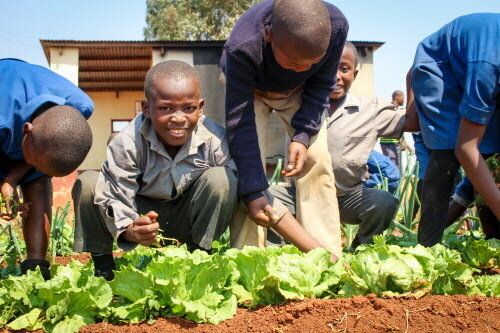
Children in Swaziland who rarely ate fresh vegetables now have them for lunch, while maintain their own school garden.
It happens every year. We go around the Thanksgiving table, each family member sharing something for which they're grateful. With two sons aged nine and 12, responses can range from "making the soccer team," to "becoming best friends with Keegan." And this is wonderful. I'm thrilled that my boys can identify some of the many gifts life brings their way.
What gives me pause is that in our land of immense privilege, it's hard for kids to appreciate the many basic things we take for granted. Take food, for instance. For many Canadian children, a full fridge is such a constant presence that it's not unusual to hear "There's nothing to eat in here!" even when a parent has just unloaded six bags of groceries.
When it comes to Thanksgiving, there's no question that my kids are grateful for the festive food on the table -- an exciting change from our usual meals at home. But like many Canadian children, they have no sense of what it means to be hungry for more than an hour or so. And even then, the next meal is always just around the corner.
Working for World Vision Canada, I have no shortage of instructive stories about hungry children overseas to share with my kids. For I've seen these children myself. I've stood and watched boys the age of my sons scrounging through rubbish heaps just to find something -- anything -- to eat. Or moms who can only feed one out of three of their children that day, and have to choose which child.
I've tried so hard and shared so many stories that my kids now switch off. Or, like my nine-year-old son Gavin, respond with anger that we adults haven't come up with a solution. "Why do you keep talking to me about this?" he asks in total frustration. "It's so horrible. But how can I fix it if you can't?"
This Thanksgiving, I'm considering a few approaches to help my kids learn about the immense blessing of food in their lives -- without turning them off with my preaching:
- Try life below the poverty line: Get a brief glimpse of what it's like to live without the food we take for granted. Depending on the age of your children, spend a day or two eating no expensive items like fresh fruit, meat, milk or butter. Instead, eat dry cereal, drink water instead of milk or juice and source lunch and dinner from tins. Keep track of the money you save and consider feeding a hungry family here in Canada through World Vision Gifts.
- Talk with a farmer: Kids whose food comes from grocery stores may not understand the many challenges involved in producing a successful crop for our enjoyment. Visit a farm or farmers' market, and ask a few questions about what goes into growing food. Is it easy to grow these apples or the wheat for these breads? What can go wrong? How does it feel when a harvest is successful?
- Get the real story: If you have a friend or neighbor who has moved from a developing country, invite them for a simple meal. Ask them what life was life in their country, especially when it came to food. What was it like to try and run, play a game such as tag or soccer, or concentrate in school when they didn't have enough to eat?
- Identify solutions: When it comes to poverty in developing countries, focus on solutions that kids themselves can be a part of. Visit the World Vision Gifts web site with your kids, to see the hope that a gift of fruit trees or two hens and a rooster can bring to a hungry family overseas. Kids may even want to make a donation toward a gift themselves.
- Make your own delivery: Rather than delivering food donations to the box at school, consider delivering them straight to a shelter for homeless people, or a drop-in lunch at a nearby church. It's important for children to see where their gifts go, and the actual people who are fed because they cared.
As I've written this piece, I've realized how often I complain about grocery shopping, cooking, or packing school lunches, all actions that result from the bounty of food in my life. I'm committing to replacing my stories and lectures with comments of joy and gratitude myself -- and not just on Thanksgiving.